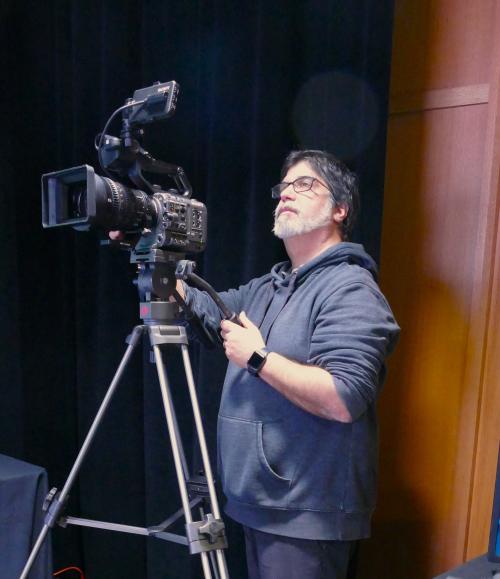
Sony Electronics Demo days bring industry-leading tech to campus
By Lesa Bressanelli, OIT Communications Intern '22-23
Sony Electronics Demo Days, held Dec. 6-8 at the Bryan Center Studios, invited members of the Duke digital and medical community to explore a wide variety of electronics, capable of assisting practitioners in upgrading marketing signage or performing surgery.

The event, organized by Scott Frey, senior audio/visual (A/V) media designer, attracted dozens of faculty and staff from across the university and at Duke Health to learn more about advanced technology that could revolutionize the way they work.
Crystal C-Series LED video wall
While the event was occurring within the building’s lower-level, attendees had a realistic, scenic view of deep, forested valleys and of sprawling city scapes on the Crystal C-Series LED video wall. The technology features a series of small, micro-LED panels that display extraordinary, large-scale visual experiences. No taller than four inches and no wider than one inch, the panels can seamlessly attach to one another in a variety of shapes and can be attached to wall surfaces of all kinds to create unique viewing experiences.
Frey believes the technology could be leveraged to reimagine numerous spaces on campus, such as classrooms, large auditoriums and meeting rooms by replacing projectors and TVs to offer people new avenues for how they produce media including videos and recorded lectures.
“It kind of gives you the opportunity to have a limitless production value while at a very low cost comparatively,” Frey said.
NUCLeUS digital imaging platform
Across the room, some attendees watched on a monitor in meticulous detail a close-up of a surgeon’s hands that were stitching a wound within a patient’s body cavity. The clarity and detail was possible as the monitoring system, known as NUCLeUS, is a digital imaging platform that streamlines video content, still images and patient data for hospitals and ambulatory surgical centers to provide medical staff with the visuals and data they need when they need it.
Steve Schnitter, senior sales account manager at Sony Health Solutions, explained that in some cases, it is so clear and detailed that surgeons would watch the screen instead of their own hands to complete procedures.
It is situations such as these that Marco Manjarrés, senior product manager for Sony’s Healthcare Solutions, sees the technology as a means for increasing interconnectivity and enhancing vision into areas that are otherwise hard to see. This is especially true as the platform’s ability to display images and videos is not tied strictly to the system’s hardware.
“Whenever the network gets better, we can increase the quality of the video and resolution so that we can keep moving forward rather than being tied down by a piece of cable that will never get refreshed,” Manjarrés said. “That’s what’s great about our system and what separates us from other solutions within the market.”
SONY FX9 video cameras and Pan-tilt-zoom (PTZ) cameras
Nearby, attendees could peer through a Sony FX9 video camera to see first-hand the high-resolution capabilities of a camera with a 6K sensor that can create media of cinematic quality utilizing S-Cinetone™ color science and a fast auto-focus system.
As people walked around the room, some saw PTZ cameras rotate, following their paths as they passed by. The display illustrated how the technology could be integrated within current technological systems and eliminate the need for a videographer, while seeing how it could further enhance presentations, meetings and lectures by enabling live streaming or recording options.
These cameras were of special interest to Tim Searles, director of media at the Fuqua School of Business, as the School looks to further improve upon its students’ educations.
“We are getting ready to deploy a couple of follow-cams in the classrooms at the JB Duke and I got a chance to see them in action,” Searles said. “I’m intrigued by the version that will zoom in on participants if they stand up to speak. I believe that both or either of these capabilities could add value to our hybrid classroom setups."
In case you missed demo days and have an A/V project you need help with, you can explore the products featured during the event and more at sony.com/pro or sony.com/medical, or contact Duke's Office of Information Technology - oit.duke.edu/help - for more information.
